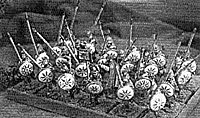Our good friend and contributor, Wally Simon, sent in his fine piece on his quandary as to how to deal with melees. The problem, from my point of view, is that he is seeking a generic ruling on melees, which can be applied across time for all periods. It's rather like saying, 'I really love this WW II Rules Set. So let's put in a few modifiers and use it to fight the Punic Wars.' I truly believe that any rules set that can transfer between historical periods that easily was probably not very good at detailing the period for which it was written, and does an equally Parker Brothers job with whatever other period to which it is applied.
The rules for melee MUST reflect the historical period being fought. In the 7 Years War, Prussian peasant infantry under iron discipline of Junker aristocrats did not go running back and forth like a ping-pong ball as the result of melee. They stood and followed orders, and took an enormous amount of punishment. However, when the Prussians broke in route, you couldn't expect to get them to advance again any time soon. (Yes, there are exceptions, but the rule should not be based upon the exception.)
In the American Civil War, an army of citizens, often as intelligent as their officers (particularly on the Union side), but lacking in the same kind of ferocious discipline, might well run away, only to rebound into the fight. (Crane's Red Badge of Courage comes to mind.) Hence, melees in an American Civil War battle can have the ebb and flow Wally desires, while for the Prussians at Kolin, when it's over, it's over. (Of course, in the 7 Years War we are talking about trained regulars, and not those chicken thieves from Croatia, who were somewhat averse to melee with regulars.)
In his article, Wally mentioned mounted knights charging mounted knights. When cavalry is defeated in melee by other cavalry, it is often driven from the field, simply because the victorious cavalry pursues and pushes it off the field. When routed in a clash with infantry, which haven't the speed to pursue horsemen, the cavalry can be rallied, as William the Conqueror did at the Battle of Hastings.
 A phalanx of men armed with long spears or pikes must be handled very
differentlysomewhat like a porcupine. Their long weapons are actually used to
keep the enemy away from them, as much as to inflict wounds and death. Once
the long pointy weapons have been pushed past, however, as the heavily armored
sword and buckler men did during the Renaissance period, then the men in the
interior of the pike block were little more than meat. The long phalanx also gained
its strength from the continuous front it presented. So long as that front held, the
phalanx could continue in melee for a long period of time. Once that continuous
front was broken, however, the ability of the phalanx to continue came to a quick
and tragic end.
A phalanx of men armed with long spears or pikes must be handled very
differentlysomewhat like a porcupine. Their long weapons are actually used to
keep the enemy away from them, as much as to inflict wounds and death. Once
the long pointy weapons have been pushed past, however, as the heavily armored
sword and buckler men did during the Renaissance period, then the men in the
interior of the pike block were little more than meat. The long phalanx also gained
its strength from the continuous front it presented. So long as that front held, the
phalanx could continue in melee for a long period of time. Once that continuous
front was broken, however, the ability of the phalanx to continue came to a quick
and tragic end.
Not all Greeks fought in a phalanx. Peltasts might engage other lightly armed troops in melee in an effort to drive in the enemy's screening troops. These same peltasts, however, would be equally unwilling to meet a phalanx in push of pike. Hence, in making rules for melee you must examine the historical period, and within the period, the types of troops to determine how they would react in melee, if they would permit themselves to be drawn into a melee at all.
Remember that 99% of all Rules Lawyers give the rest a bad name, & 47.3% of all their statistics are made up on the spot.
Back to Novag's Gamer's Closet Winter 2003 Table of Contents
Back to Novag's Gamer's Closet List of Issues
Back to MagWeb Master Magazine List
© Copyright 2003 by Novag
This article appears in MagWeb.com (Magazine Web) on the Internet World Wide Web. Other articles from military history and related magazines are available at http://www.magweb.com